"Phoenix" Trees Rise from the Ashes
Air Date: Week of January 26, 2024
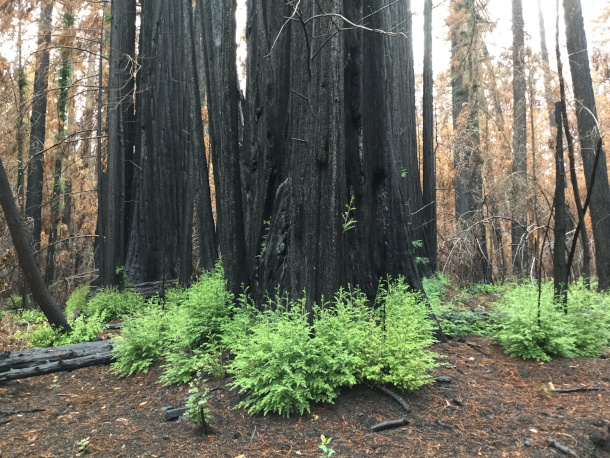
Sprouts at the base of a redwood tree in February 2021, 5 months after the 2020 CZU lightning complex fire. (Photo: Melissa Enright, co-author of the study “Old Reserves and Ancient Buds Fuel Regrowth of Coastal Redwood After Catastrophic Fire”)
Nearly all the tall coast redwoods in California’s Big Basin Redwoods State Park burned in a 2020 wildfire. But within a few months, the charred trunks had grown a fuzz of healthy green shoots. A new paper documents how the trees were able to regenerate using energy reserves stored for many decades. Lead author Drew Peltier teaches at the University of Nevada – Las Vegas and joins Host Jenni Doering to explain the science behind this stunning recovery.
Transcript
DOERING: Coast redwood trees are the tallest in the world at over 300 feet, and that height, as well as their thick bark, usually keeps their upper branches and needles safe from wildfires. But in the hot, dry summer of 2020, the CZU Lightning Complex Fire climbed straight into the heart of California’s Big Basin Redwoods State Park and up into the crowns of its iconic redwood trees.
[FIRE SFX]
DOERING: As the Park lay smoldering, rangers returned to see what remained.
RANGER 1: We finally make it to Park headquarters and there’s nothing left.
RANGER 2: The visitor’s center, the shop, residences, every vehicle in the fleet: gone. It’s all gone. And on top of that, you know, we talk about facilities like they’re structures, our trail system got hammered. We lost everything. You can say, we lost everything.
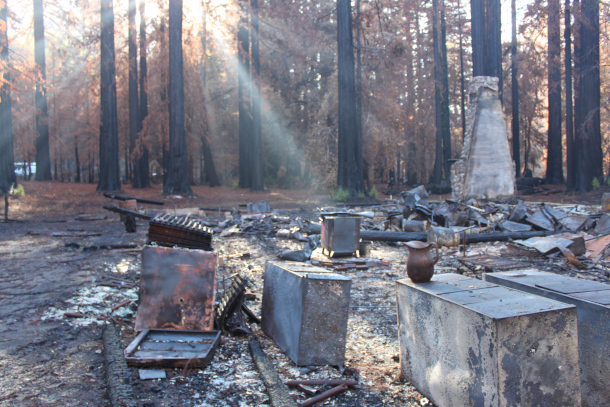
Study coauthor Lissy Enright took this photo of what remained of the Big Basin Redwoods State Park visitor center after the fire. (Photo: Lissy Enright)
DOERING: 97% of Big Basin had burned, including almost all of its coast redwood trees. Though many still stood, they were completely blackened all along their trunks, without any needles intact. But incredibly, within a matter of months these redwoods began to grow fresh, bright green needles. A group of Northern Arizona University scientists and other researchers visited the forest after the fire to learn its secret. Lead author Drew Peltier is an assistant professor in the School of Life Sciences at the University of Nevada Las Vegas, and he joined us to explain the science behind this stunning recovery.
PELTIER: Redwoods are really remarkable in that they have this ability to resprout after fire. They have a lot of really neat fire adaptations, they have super thick bark at the base up to a foot thick. They're also just really, really tall, which helps to survive fires, because you're often above the flames. And all those things mean that they usually survive fire events, it seems like, and then they have this remarkable ability to regrow new leaves after the fire, even if they lose them all. And so we were there to kind of study these resprouting individuals. And so what you have now a couple years later, is what we've been calling these green telephone poles. So these trees that have lost all their branches, but then they've resprouted new foliage all on their stems. And so yeah, it's much less shady, it's a much different place than it was before the fire.
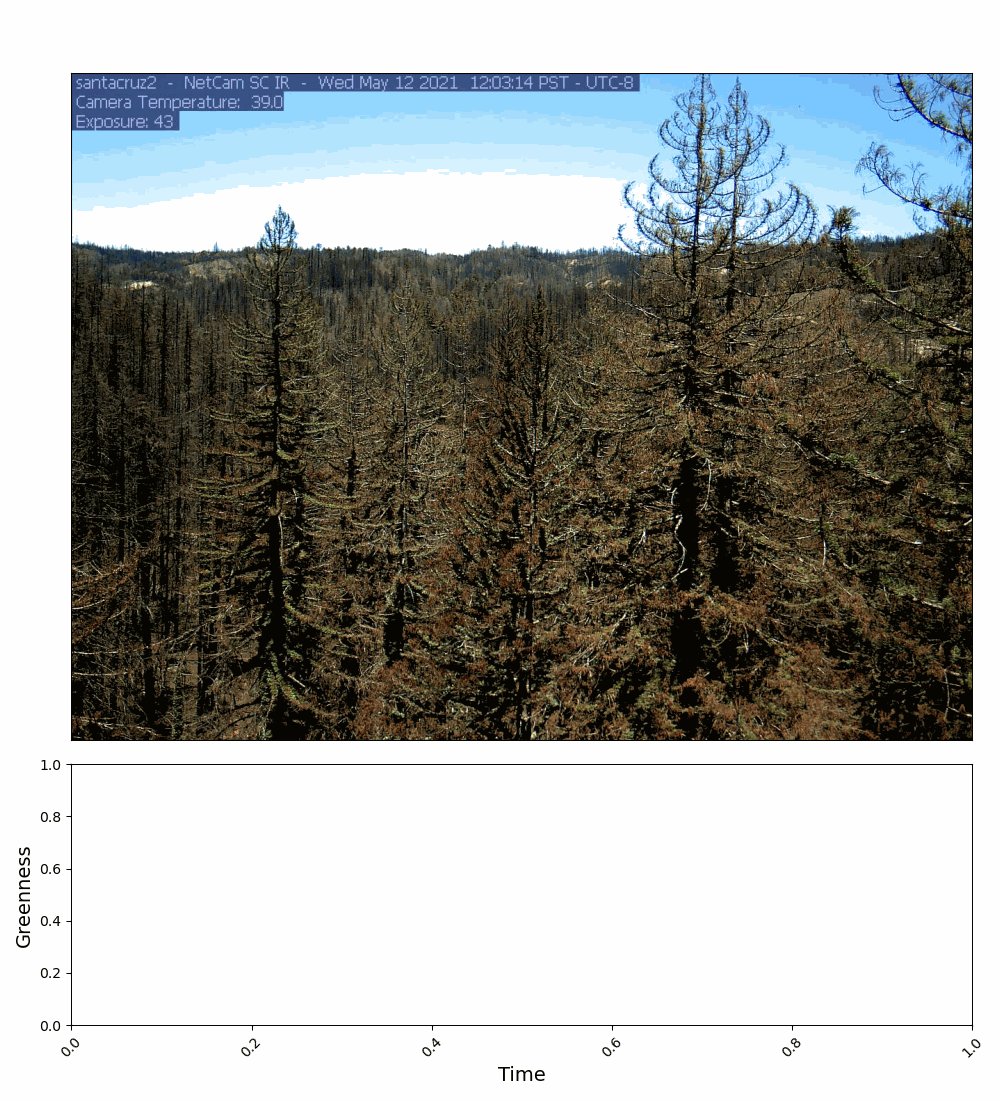
DOERING: That sounds like a really strange and different kind of forest to stand in. And you're talking about [LAUGH] green fuzzy telephone poles. So the sprouts aren't just coming from the base of these trees.
PELTIER: No, these trees resprouted from everywhere: from the roots, from the stems, from branches if they managed to keep some of them. It's really kind of all over these trees. They produced a really gigantic amount of new foliage from these buds that they maintain. And so it seems like they were really primed to very rapidly recover after this fire event.
DOERING: So tell me about this transformation. I mean, given this devastation with, you know, this intense fire that went all the way up into the crown and burned all of the green needles—for these trees to then have all of this new green growth. How is this happening?
PELTIER: Yeah, so the way that these trees do this is there are kind of two key adaptations that our study was really about. The first is that, well, they store a lot of energy, because you need energy to grow. And when you don't have any leaves as a tree, you're not bringing in any new energy through photosynthesis. And so one of the things we did was to look at sort of the age, essentially, of those energy reserves or carbon reserves, and basically that's just in the form of things like sugars and starch. And so by using this process called radiocarbon dating, we were able to estimate that some of these carbon reserves were on the order of 50 to 100 years old. So to think about that another way, what that means is that carbon that was photosynthesized from the atmosphere, potentially back in the 1940s and 50s, is being used to regrow new leaves now after fire. So really, really long-term storage of energy. And kind of the second part of that is they have to have the anatomical tissues to grow these new leaves. And so the other really amazing thing that we found is when you look in the wood underneath these, these little sprouts coming out of the stem, what we saw was a line going all the way to the center of the tree, which basically means that these sprouts arose from really ancient bud tissue, so buds that were sort of as old almost as the tree itself, which in some cases could be thousands of years. So that's just sort of was shocking to us. It's this really long-term preservation of bud tissue. And those two things together—really large amounts of very old carbon reserves and lots of really ancient buds—means these trees were very prepared in a sense.
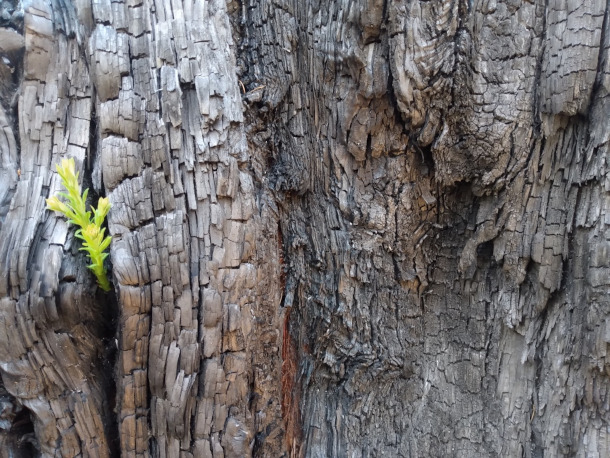
A small sprout emerging from a very large redwood. (Photo: Drew Peltier)
DOERING: And it sounds like if these buds are just sprouting now, all this time they've been lying dormant, they go all the way back to in some cases when that tree first sprouted. So somehow, it sounds like, the tree knew, you know, this is my savings account. I need to keep this around in case I need it someday. And this is the moment.
PELTIER: Yeah, I mean, I guess that's one way to think about it, for sure. A useful comparison, I think, is to the giant sequoia in California. So these are the other giant tree species that lives in California. They unfortunately do not have this ability to do this resprouting thing. And a lot of those trees actually burned as well in 2020 and also in 2021. And those two fire events combined, I think, killed around 15% of the largest giant sequoia in California. So 15% of the largest giant sequoia on Earth. Because essentially, when those trees lose all their leaves, that's kind of it. It’s game over. So this resprouting adaptation, this maintenance of buds for really long time periods, is a super important adaptation, it seems like, to extreme wildfire.
DOERING: So not all trees can do this.
PELTIER: Definitely not. It's pretty common in, you know, what we call broadleaf trees. You know, what you think about in the East with the autumn colors, things like maples and hickory, lots of those trees, particularly oaks, will resprout from the base. It's almost entirely absent in pines, and it seems to be a thing in the Cupressaceae, so this is stuff like junipers, cypress, redwood.
DOERING: So you mentioned these carbon stores that are really old. That's the way that these trees were able to grow new tissue, new green needles after this fire. Where exactly are they storing this and how?
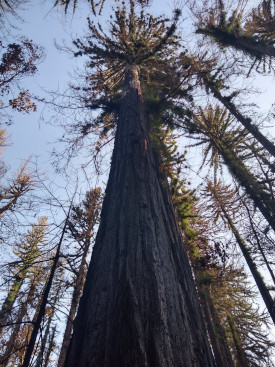
A giant sequoia where Drew Peltier installed a phenocam, a digital camera used to monitor ecosystem dynamics over time. Many giant sequoias are between 250 and 300 feet tall, the tallest being about 325 feet high. (Photo: Drew Peltier)
PELTIER: Yeah, so, everywhere, is the answer to that question. In all living cells. You know, animals have fat cells. That's how, you know, you and I, and my dog, store our energy. But plants do not have that. Some of them store lipids, but mostly they store energy in the form of sugars and starches. And those are stored pretty much throughout the tree. Some trees have specialized below-ground organs, but in redwoods it's everywhere in living cells. So in branches, in leaves, in the stem, in roots. But the oldest reserves seem to be in really, really deep tree rings.
DOERING: So how did you actually figure out how old these stored carbon reserves were?
PELTIER: Yeah, so we did a bunch of sampling for this study, but the main thing we did was simply just to collect some of these little sprouts. So Lizzy Enright, who’s a co-author on our paper, was out there in just a couple of months after the fire, and she covered parts of the bark, basically, to keep those sprouts from photosynthesizing. So they only were drawing on stored carbon reserves. And then we just sort of clipped them when they got big enough and used them for analysis. And so the way that we actually figure out the age of the reserves that were used to build those sprouts, is based on what's called radiocarbon dating. And so the way to think about this is kind of by using a bookmark, and the bookmark in time is basically atmospheric bomb testing in the 50s and 60s. And so, you know, this was a pretty strange period in human history, but one thing that did happen was we basically doubled the concentration of radiocarbon in the atmosphere. Since that time, we've stopped testing nuclear bombs in the atmosphere, which is great, and so as a result, that concentration of radiocarbon has dropped off over time. And so what we can do is simply just look at the carbon that's in this little sprout and see how much radiocarbon is there now using what's called accelerator mass spectrometry. And by comparing it to that kind of annual record that we have of radiocarbon, we can estimate how old it is. And so I say how old, but what I really mean is that's a measure of how long it's been since that carbon was photosynthesized from the atmosphere. It's a measure of sort of how long that sugar has been sitting in that tree before it was used.
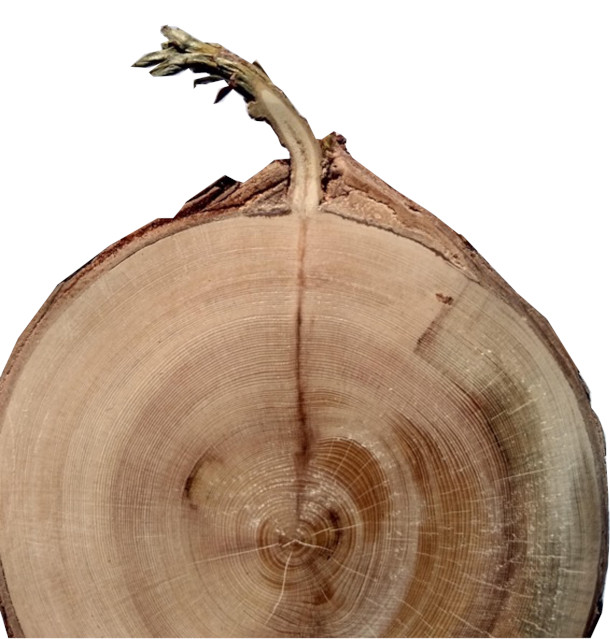
This is a cross section of a branch showing the "bud trace" of a sprout. These same structures are present on the main stems of these resprouting redwoods, showing the buds that grew these sprouts may be thousands of years old. (Photo: Drew Peltier)
DOERING: So how does your research add to previous knowledge of tree growth?
PELTIER: So we have a lot of models of the global climate system, and what are called dynamic global vegetation models, or terrestrial vegetation models. And a lot of these make certain assumptions about how tree growth works, because tree growth is a really important process in the global carbon cycle. Forests pull huge amounts of carbon out of the atmosphere every single year and so kind of having a good handle of that and being able to predict that process going forward is a really important constraint on atmospheric carbon dioxide, basically. One assumption of many, many models about how tree growth works is that there's basically little or no storage of photosynthate or carbon reserves over time. And so what we've shown is not only are there really, really old reserves present in these very old trees, but also there are pretty substantial amounts of them. So in one estimate, it seems possible that there were perhaps hundreds of kilograms of 50-year-old carbohydrates in these trees, in the old ones. And so that's like a small motorcycle of sugar from 50 or 60 years ago. So it's a pretty big amount.
DOERING: Yeah, that is fascinating. So not only is this a story about how these forests are being affected by climate change induced impacts, like wildfires that are getting worse, but also we're learning potentially how we can improve our climate models.
PELTIER: Definitely. There's more and more research that I'm doing, at least, this is something that I work on, that basically shows that trees have this so-called memory of past climate, and they respond to their environment over really long timescales because they live a really long time. And so this storage of carbon reserves is one mechanism for how that works. So we know, for example, drought can leave really long legacies on tree growth, where trees grow more slowly for up to five years after drought events. And so there are similar examples of that in the literature, but this is sort of how that works, basically. Trees are doing photosynthesis all the time, they're putting energy into this kind of gas tank of sugars and starch, and they're using it to grow at different times. And when times are bad, maybe they draw a little bit more on this gas tank, and when times are good, maybe they put more in. But what this study shows is that there are really, really old energy reserves in that pool of carbon, at least in old trees. You know, some of these trees were upwards of 2000 years old.
DOERING: What does it feel like to study trees with such long lifespans compared to ours?
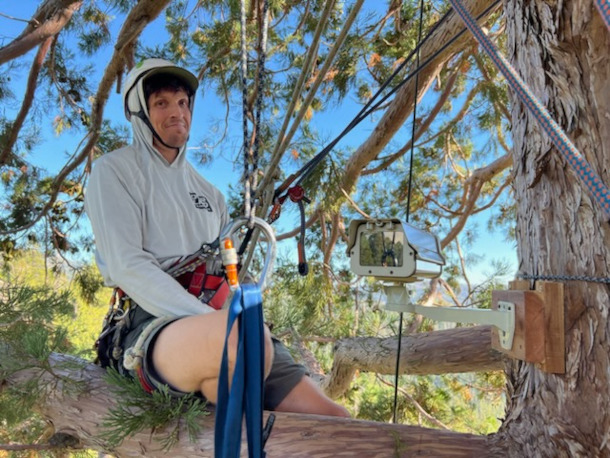
Drew Peltier at the top of a giant sequoia installing a new phenocam to monitor some fire impacts in the Mariposa Grove in Yosemite National Park. (Photo: George Koch, co-author of the study “Old Reserves and Ancient Buds Fuel Regrowth of Coastal Redwood After Catastrophic Fire”)
PELTIER: Well, I can answer that by an experience I had recently in a different tree species, but recently I was in Yosemite in the Mariposa Grove in giant sequoia trees, basically, and we got the opportunity to collect some tree cores. And I took a tree core from one of these giant sequoia that was just really, really big and had all these fire scars. And when I took the core out it became immediately obvious, you can tell when the rings are really, really small and really, really close together, that this tree was just thousands of years old, and I cried, basically. It was just a really emotional experience for me. I mean, they're, you know, I think everyone has to go to these old growth redwood groves and giant sequoia, because the pictures just do not do it justice. You know, when you go, I assume you'll have the experience of trying to take a picture on your phone, and you just can't capture it unless there's like a bus in there or something for scale. They are just kind of beyond belief in terms of how large they are, and they're really just magical, really important places that I think we need to preserve.
DOERING: Drew Peltier is an assistant professor in the School of Life Sciences at the University of Nevada Las Vegas. Thank you so much, Drew.
PELTIER: Thanks very much for having me. It was great to chat with you.
Links
Living on Earth wants to hear from you!
Living on Earth
62 Calef Highway, Suite 212
Lee, NH 03861
Telephone: 617-287-4121
E-mail: comments@loe.org
Newsletter [Click here]
Donate to Living on Earth!
Living on Earth is an independent media program and relies entirely on contributions from listeners and institutions supporting public service. Please donate now to preserve an independent environmental voice.
NewsletterLiving on Earth offers a weekly delivery of the show's rundown to your mailbox. Sign up for our newsletter today!
 Sailors For The Sea: Be the change you want to sea.
Sailors For The Sea: Be the change you want to sea.
 The Grantham Foundation for the Protection of the Environment: Committed to protecting and improving the health of the global environment.
The Grantham Foundation for the Protection of the Environment: Committed to protecting and improving the health of the global environment.
 Contribute to Living on Earth and receive, as our gift to you, an archival print of one of Mark Seth Lender's extraordinary wildlife photographs. Follow the link to see Mark's current collection of photographs.
Contribute to Living on Earth and receive, as our gift to you, an archival print of one of Mark Seth Lender's extraordinary wildlife photographs. Follow the link to see Mark's current collection of photographs.
 Buy a signed copy of Mark Seth Lender's book Smeagull the Seagull & support Living on Earth
Buy a signed copy of Mark Seth Lender's book Smeagull the Seagull & support Living on Earth

